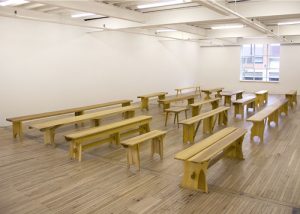They didn’t offer a course in woodworking or ‘shop’ at the Yeshivah of Flatbush, where I attended high school, and even if they had, I doubt I would have been the least bit interested.

Seventeen wooden benches, fashioned out of poplar, take up residence in the gallery’s austere main room, their clean, unfussy lines echoing the tightly wedged, slender planks of the wooden floor on which they rest. There’s no explanatory text panel, no sound, no video -- no hidden aesthetic agenda -- to distract the viewer from the objects on display. What you see is, well, what you see: row upon row of beautifully made benches of varying size, lovingly and subtly detailed.
It turns out, though, that there’s a fascinating back story, a history, to these benches. In constructing them, Mr. Cape took his cue -- quite literally -- from the backless prayer benches built by the Shakers and other American religious communitarian groups of the 19th century. He measured the originals, researched the ways in which they were used, and then constructed his own.
The gallery prefers to call them “sculptures.” The New York Times describes them as “faith-based furniture.” Students of religion might label them “shared seating,” focusing on their relationship to community and ritual, the leveling of social status and the promotion of equality.
By whatever name (and corresponding perspective), Cape’s benches not only succeed, on their own terms, as art. They’re evocative of history, too, underscoring the ways in which faith, then as now, assumed material form.
That’s what I’d call an ‘object lesson.’



